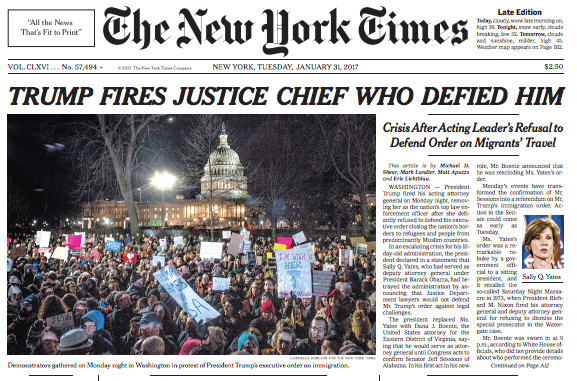The story of Donald Trump’s political rise is incomplete without mention of a balkanized information environment. But the flurry of news emanating from the White House over the past week reveals a particularly clear view of two parallel media universes: mainstream and right-wing. A side-by-side comparison of their relative portrayals of the Trump administration illustrates the gaping divide between these divergent narratives—and the difficulty ahead for news organizations to regain broad-based public trust. The problem is not one of just alternative facts, it turns out, but alternative realities.
The view from the Fox News-Breitbart axis—an admittedly vague and not necessarily conservative ecosystem that includes blogs, Facebook pages, and conspiracy sites—is rosy. From that lens, Trump is fulfilling his campaign promises to shore up our borders and target radical Islamic terrorism. Violent leftists, backed by a George Soros-funded conspiracy, are responding with a crusade for political correctness. The crooked, drive-by media is the opposition. Questions of implementation, process, and communication are sideshows. “For now, Trump is winning again,” Breitbart’s Matthew Boyle wrote in a Monday analysis casting Trump as a Reaganesque figure. “And he’s in charge.”
Contrast that with prevailing mainstream narratives of executive incompetence, administrative chaos, and public outrage, all framed within nods to creeping authoritarianism and philosophical questions about American ideals. “Nearly every new president has a learning curve,” The New York Times wrote in its own analysis of the transition. “But the curve seems especially steep for Mr. Trump.” The mainstream view of the world exhibits far more reporting and critical thinking, and the president’s low approval ratings suggests this aggressive journalism is having an impact.
At the same time, mainstream journalists are actively diminishing their own credibility by hyperventilating about every unconfirmed Trump rumor that pops on Twitter. He photoshopped his hands! He’s allowing companies to do business with Russian security agencies! He’s on an unannounced helicopter flight! The group freakout only confuses audiences and alienates Trump-wary Republicans to the point that legitimate stories don’t get traction.
The extent to which many otherwise smart Trump defenders won't believe ANYTHING from mainstream press is remarkable. Poisonous to democracy.
— Josh Kraushaar (@HotlineJosh) February 2, 2017
How to bridge that gap is perhaps the central question facing the press in our era of alternative realities. Snapshots from a head-spinning week in national politics provide glimpses of the challenge ahead:
‘Muslim ban’
Mainstream media framed Trump’s refugee order in the context of religion from the outset. After all, candidate Trump did propose a “Muslim ban” on the campaign trail. He added in an interview with the Christian Broadcasting Network last week that Christians would get priority in his vetting process. Still, despite many protesters reading between those lines, journalists largely described the action as targeting “Muslim-majority countries” or the like.

Front-page headlines from The New York Times, left, and The Washington Post, right, on January 28.
Conservative media has pushed back ferociously on the idea that religion is part of the equation, from the august National Review to far-less-august Daily Caller. Breitbart has run multiple pieces arguing the same, describing the list of countries as “eminently sensible.”
Posted by Breitbart on Saturday, January 28, 2017
Fox News’s lead Trump acolyte, Sean Hannity, lobbed a characteristic softball question to Vice President Mike Pence with the following windup on Thursday: “It’s been misreported as a ‘Muslim ban.’ Yet the news media continues to say it’s a ‘Muslim ban.’ Is that fake news?” Hannity reports; you decide.
The spirit of protest
The Sunday morning talk shows led with the chaos and outrage that came in the wake of Trump’s hastily implemented order. CNN and MSNBC covered the ensuing protests copiously on cable and online. And Monday morning newspapers across the country—big and small—led with the fallout. They were filled with tales of travelers in limbo, families separated, and peaceful demonstrations:
'LINES DRAWN' pic.twitter.com/JEFVNKYIVF
— David Uberti (@DavidUberti) January 30, 2017
Right-wing outlets gave shorter shrift to both the human stories of stranded travelers and the protests that followed. Breitbart reported on how the demonstrations snarled traffic, seething on Facebook, “People who actually work for a living are growing frustrated with the ‘protestors’ showcasing their selective outrage that was nowhere to be found when Obama banned refugees.”
Hugely popular radio host Rush Limbaugh, meanwhile, drove home the conspiratorial Soros theme when discussing lawsuits filed on behalf of those affected: “The protests at the airports bought and paid for by George Soros, prearranged. People have been sitting and waiting for the moment to be cued to action….They have been poised and waiting for marching orders, and the executive order was issued and the marching orders went out. The protests are typical of the way the media does things.”
Who is bankrolling the protests taking place at airports across the country? More with @newtgingrich right after the break #Hannity
— Sean Hannity (@seanhannity) January 31, 2017
Selective outrage
When an unrelated and comparatively small protest of right-wing provocateur Milo Yiannopoulos shut down the University of California, Berkeley campus, The New York Times devoted just a short news item to it online. Mainstream media had largely moved on to a bungled special forces raid in Yemen, second-day analysis of Trump’s Supreme Court pick, and America’s increasingly tenuous relationship with its allies, among other news.
Right-wing media, on the other hand, portrayed Berkeley as the frontline of the culture war. Gateway Pundit, a popular blog veering toward conspiracy theory, ran seven pieces on the news between Wednesday and Thursday. Breitbart similarly went hard on the storyline, particularly after Trump—that is, “Sheriff Trump”—floated the idea of withdrawing federal funds from the university. On Fox News, Tucker Carlson interviewed Yiannopoulous in a widely shared conversation about political correctness run amok.
Milo Yiannopoulos on @UCBerkeley riot: "That is the price you pay for being a libertarian or conservative on American college campuses." pic.twitter.com/XiSSjSj1KH
— Fox News (@FoxNews) February 3, 2017
Crushing dissent
Mainstream journalists immediately reverted to Nixonian analogies when Trump fired his acting attorney general, Sally Yates, for refusing to enforce his refugee order. The Times and Post both plastered the news on their front pages dueling six-column headlines. Much attention was also given to the text of Trump’s announcement, which said that Yates “betrayed the Department of Justice.”

Right-wing media focused on Trump’s right to fire Yates for insubordination, rather than what read like an unhinged response to dissent. The narratives diverged even further when news broke soon after that a dissent cable had been widely circulated throughout the State Department. Fox & Friends transmitted the message with Trump’s signature catchphrase, “You’re fired.” Breitbart Senior Editor Joel B. Pollak took the hardline stance in his analysis of the administrative pushback, arguing that “the bureaucracy must surrender.”
There is a place for criticizing the president — namely, outside of the government. There are places for challenging Trump’s authority — namely, the opposition benches, the courts, and ultimately the ballot box. Those who abuse the power of the bureaucracy to defy the electorate, and the Constitution, may think themselves heroes, but they are destroying the foundations of liberal democracy. They must go.
American symbols
There was even disagreement over the metaphorical power conveyed by the Statue of Liberty. On Monday, Lester Holt hosted NBC Nightly News, the highest-rated evening news program, with Lady Liberty standing over his shoulder. “Behind me,” he opened the show, “the Statue of Liberty, which for nearly 130 years has symbolized the welcome arms of a country of immigrants. But tonight she also stands as a symbolic flashpoint in a country in the midst of soul searching over the limits of its generosity in an age of international terrorism.”
It was a fairly down-the-middle, seemingly uncontroversial report. But Limbaugh fired back on his radio show the following day, alerting listeners that Emma Lazarus’s famous poem on the statue’s base was added years after it was erected. “The Statue of Liberty does not say, “You want in? This is the way!” Limbaugh said. “Now, I imagine some of you are saying, ‘Rush, did you get a little overboard on this?’ No, folks. It may sound like I’m going a little overboard, but I’m a stickler for truth and fact here, and this is all being used to work up what is already deranged lunacy on the left.”
David Uberti is a writer in New York. He was previously a media reporter for Gizmodo Media Group and a staff writer for CJR. Follow him on Twitter @DavidUberti.

